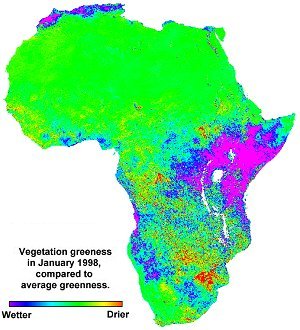|
El Niño / Southern Oscillation Patterns
About every two to seven years there is a warming of the shallow layers of the equitorial
Pacific Ocean called an El Niño pattern. Trade winds oscillate during the same period,
in a pattern termed the Southern Oscillation. We now know that El Niño and the
Southern Oscillation are related patterns, known by the shorthand ENSO. The patterns typically
last 12 to 18 months, and together with the related climate pattern La Niña, can affect
climates all over the world. The US National Oceanic and Atmospheric Administration has
prepared excellent information on ENSO.
 ENSO climate patterns vary markedly across the Earth. In East Africa (see the figure illustrating the 1998 El Niño year), for example, El Niño
brings heavy rains and flooding. In contrast, in our study area of Vryburg, South Africa, El
Niño brings droughts. As examples, there were droughts in South Africa in 1982-1984, 1986-1987,
1990-1992, and 1997-1998.
ENSO climate patterns vary markedly across the Earth. In East Africa (see the figure illustrating the 1998 El Niño year), for example, El Niño
brings heavy rains and flooding. In contrast, in our study area of Vryburg, South Africa, El
Niño brings droughts. As examples, there were droughts in South Africa in 1982-1984, 1986-1987,
1990-1992, and 1997-1998.
Those making climate forecasts are now using advanced methods to incorporate ENSO patterns into their
predictions. Oceanic warming is evident well before changes in local climate are expected. That allows
forecasters to use mathematical models to predict the probability of droughts and heavy rains.
We are not involved directly in forecasting ENSO climate patterns, but instead in working to assess
and improve the way those forecasts are presented to livestock owners.
|



